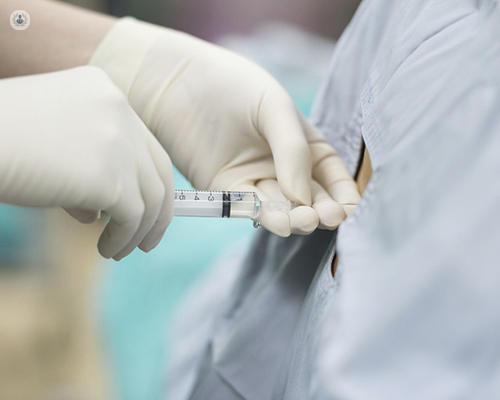Epiduroplasty
What is an epiduroplasty?
An epiduroplasty, also known as an epiduroscopy or epidural endoscopy, involves inserting a small tube (catheter) equipped with a camera into the spine. With the additional use of x-ray vision, a specialist can produce images of the nerves and fibrotic tissue inside of the epidural space and treat back pain.
It is a fairly new and effective technique to relieve chronic pain caused by conditions such as inflammation of the vertebrae, chronic back pain and some cases of spinal narrowing by inserting anti-inflammatory medication. As well as relieving pain, this procedure can also allow a specialist to observe the epidural space and diagnose the cause and treat it at the same time. It is a painless, minimally invasive procedure that lasts around one hour and is performed under local anaesthetic. The patient doesn’t require an overnight stay in the hospital.

How is an epiduroplasty performed?
It is usually done in the operating room using x-ray vision. You will need to lie on your front and be injected with local anaesthetic injections to numb the area of your back. To ensure the catheter is in the right place, a small current will be applied, creating a tingling sensation in your leg or where the pain is, to identify the pain correctly.
Depending on the reason for the procedure, the doctor may insert more medication. They may also need to administer some dye to visualise the epidural space better.
After the procedure, you will be placed on your back, and your legs may feel slightly heavier and/or numb. The anaesthesia should only last a few hours and you will be given some antibiotics to take for the next few days to prevent any infections.
What are the risks?
All medical procedures carry some risks, but the chances of experiencing side-effects or complications following this procedure are very small. You may experience a temporary increase in your pain symptoms due to the treatment and the injections in your back.
There have also been cases of people having headaches afterward - but this is temporary and can be treated by lying down, taking painkillers and drinking plenty of water. As you are awake during the procedure, you can tell the doctor if you are experiencing any discomfort or shooting pains.
How should I prepare for an epiduroplasty?
An epiduroplasty is an outpatient procedure and you will be discharged on the same day. You must stop eating six hours before the procedure and stop drinking two hours before. You should also arrange for someone to pick you up after it as some people don’t feel well enough to drive straight after.
Which specialist performs an epiduroplasty?
A doctor responsible for performing an epiduroplasty is a pain management specialist.


